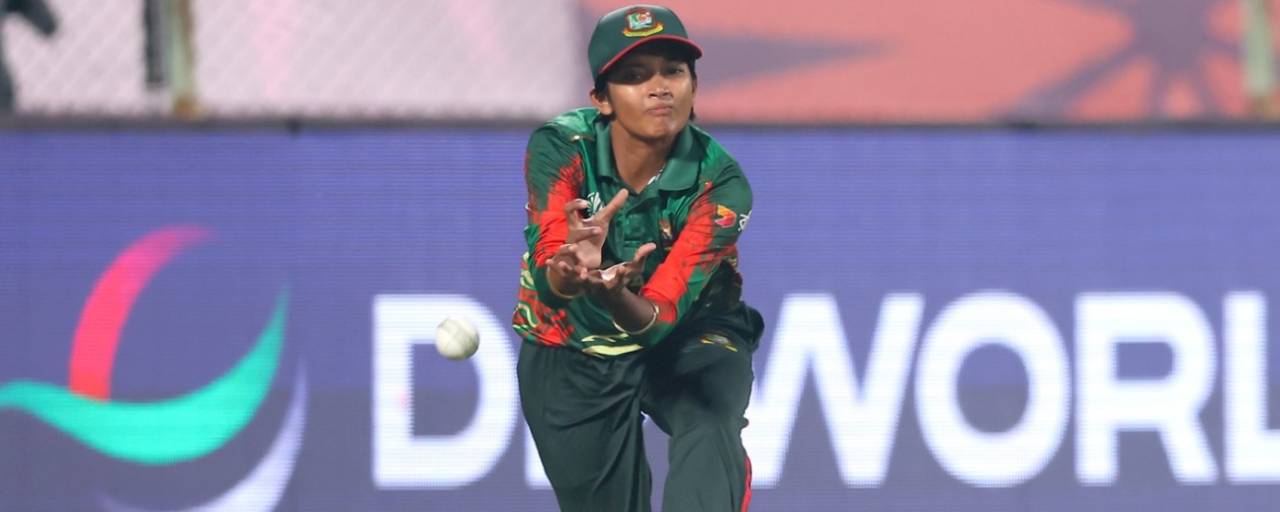Top-order turbulences, left-arm spin traps and catching concerns
What are the major trends to emerge at the halfway point of the league stage of the women's ODI World Cup?
Namooh Shah
14-Oct-2025

Dropped catches have been a feature at the World Cup • ICC/Getty Images
With exactly half the group-stage matches done at the women's ODI World Cup, a few distinct trends have begun to emerge. Batting has been far from straightforward, left-arm spin has dominated across surfaces in India and Sri Lanka, and fielding lapses continue to tilt games in unexpected ways.
Top-order turbulence
The most notable pattern at this World Cup has been the diminishing influence of top-order batters and their lack of partnerships. Across the first five wickets, batting pairs have averaged only 27.3 per stand, a steep decline from the 46.3 in the lead-up to the big event across India and Sri Lanka. After 15 century stands before the tournament, there have been just three in the World Cup, reflecting how teams have struggled to build a foundation up front.
Through overs 1-10, across 26 innings, teams have scored at a strike rate of just 65 and averaged 27.9, compared to a strike rate of 83 and an average of 57.1 in similar pre-tournament conditions.

ESPNcricinfo Ltd
Rescue acts from the lower order
While the top has wobbled, the middle and lower orders have often come to the rescue. Partnerships for wickets six to nine have averaged 25.3, the highest in any women's World Cup , surpassing the previous best of 19.0 from 2017.
Teams have rebuilt and counterpunched late, leading to a clear pattern in scoring progression: strike rates rise from 65 in overs 11-30 to 80 in overs 31-40 and 112 in the final ten. The big rescue acts have been from Richa Ghosh and Nadine de Klerk, both from No. 8, in the India vs South Africa fixture.
Left-arm spin the trump card
If there's one bowling type dictating the narrative, it's left-arm spin. Slow left-arm orthodox bowlers have produced the best returns of any bowling style this World Cup: 62 wickets at an average of 19, striking every 28 balls. The next best is legspin, averaging 26.7, nearly eight runs more than left-arm spin.
That efficiency marks a remarkable improvement over recent editions of the World Cup as well, where left-arm spin averaged 28.1 in 2022 and 31.7 in 2017.
Currently, five of the top-ten wicket-takers of the tournament are left-arm spinners: Sophie Ecclestone (9), Nonkululeko Mlaba (8), Inoka Ranaweera (7), Sophie Molineux (6), Linsey Smith (6).

ESPNcricinfo Ltd
Run fests and spin traps
Visakhapatnam and Indore have offered batting-friendly surfaces. Visakhapatnam have hosted four of the 250-plus totals, out of six, so far, including the record chase of 331 by Australia against India, while Indore has seen 230-plus totals in all four innings played there.
At venues like Guwahati and Colombo, averages drop below 21 per wicket compared to 32.8 at the other two venues. At Guwahati and Colombo, teams have been all out under 200 seven times out of 13 in total.

ESPNcricinfo Ltd
Catching continues to be a worry
Fielding has been a major concern. New Zealand (90%), Pakistan (84.2%) and England (80%) have led the way in catching efficiency, while India (55.6%) and Bangladesh (61.9%) have been among the poorest.
Interestingly, some sides have capitalised on the opposition's generosity. India and South Africa, for instance, have benefited from the lowest catching efficiency against them - 67.4% and 57.9%, respectively. Nadine de Klerk being dropped by Shorna Akhter in the penultimate over of the chase on highest in Monday was one of the decisive moments of Match 14.
DRS dilemmas
If fielding lapses have been one half of the story, indecision with the Decision Review System (DRS) has been another: 21 umpire decisions out of 55 have been reversed at this World Cup, almost identical to 23 overturns out of 56 in 2022.
Namooh Shah is a stats analyst at ESPNcricinfo